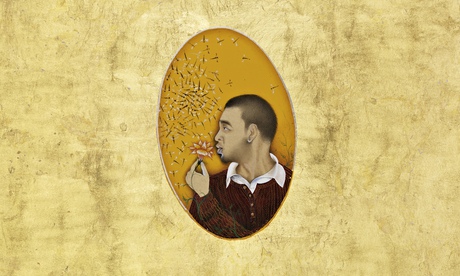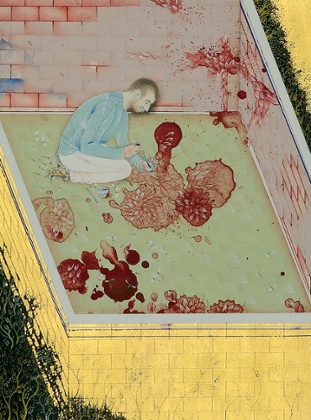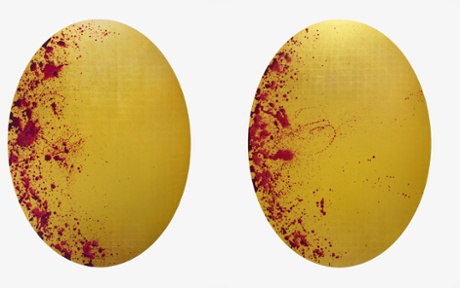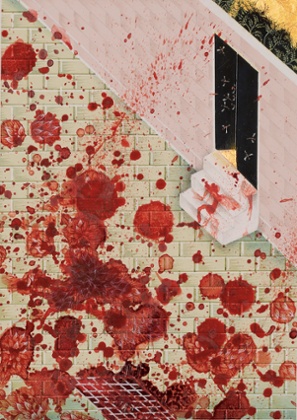Another city, another important art gallery/museum, another solo show, another set of rave reviews - Imran Qureshi continues to impress us and the world !
-------------------------------------------------------------
Imran Qureshi review – a hauntingly beautiful show at the Ikon Gallery
By Laura Cumming
Source: The Guardian
November 23, 2014
Ikon Gallery, Birmingham
Pakistani artist Imran Qureshi is a master miniaturist who also has bigger things on his mind
Source: The Guardian
November 23, 2014
Ikon Gallery, Birmingham
Pakistani artist Imran Qureshi is a master miniaturist who also has bigger things on his mind
 Self-portrait, 2009 (detail) by Imran Qureshi, in gold leaf and opaque watercolour on
Self-portrait, 2009 (detail) by Imran Qureshi, in gold leaf and opaque watercolour on wasli paper. Photograph: © Imran Qureshi/Ali & Amna Naqvi Collection, Hong Kong
There is a self-portrait in this hauntingly beautiful show by the award-winning Pakistani artist Imran Qureshi that shows him at work, pigment in one hand, brush in the other – so far just like any other painter. But Qureshi is not working on a picture, or upon a canvas, and he does not appear in any kind of studio.
Instead he shows himself kneeling inside of one of those rectangular stone enclosures surrounded by intricate foliage and gold leaf familiar from Indian miniatures. One sees him from above too, a bird’s-eye view of a tiny smiling man working happily upon the floor with the sharpened tip of his brush. The shock is that he seems to be painting pools of blood.
Blood-red paint – and all the many ways in which he uses it – have become something of a trademark for Qureshi. Born in Lahore in 1972, he has lived through decades of martial law, terrorism, uprisings and massacres, and there is no question that his medium is metaphorical. But what makes his work so profound is that this metaphor appears infinitely various.

Opening Word of This New Scripture, 2013 by Imran Qureshi. Photograph: © Imran Qureshi/ courtesy Corvi-Mora, London
The same paint (Winsor & Newton’s perylene maroon, should you wish to try it) turns crimson, scarlet, the palest of pink for air and light, the darkest oxblood for violence. A video work shows a pair of footprints slowly appearing and disappearing out of white light, trudging left and right, forming out of bloody paint that is in turn delicately worked with the brush-tip to describe miniature leaves and flowers. The feet are one with the land; a country of beauty and bloodshed. The title of the associated paintings is a further jolt: This Leprous Brightness.
Qureshi still lives in Lahore, where he is a master, and professor, of the demanding art of miniature. An earlier self-portrait shows him blowing upon a flower, its petals mutating into dragonflies that scintillate in the air around him, an exquisite image that recalls both Mughal and Elizabethan traditions. Imagine Nicholas Hilliard’s Young Man Among Roses translated to the subcontinent on a blazing gold day.
One senses this exacting vision operating through the work on every scale. Another video shows his Lahore balcony minutely painted all over with the kind of angel-wing feathers, flowers and shrubs one sees in Indian miniatures. Dragonflies settle sporadically on these illusions before lifting off in confusion, while traffic roars menacingly in the distance. Blood-red pinpricks blossom into red roses. Tiny calligraphic tendrils turn into capillaries, which proliferate into Arabic script that grows into larger abstract forms. Everything is interconnected and Qureshi’s idiom as an artist has affinities with them all.

Give & Take, 2013 by Imran Qureshi. Photograph: Daisy Loewl/© Imran Qureshi, courtesy Corvi-Mora, London
This series develops as subtly as the individual titles themselves: Walled Tree, Tight Security, Lahore Resolution; and finally, disastrously – the missile now sideways in a horizontal box of cerulean blue, evidently on its way to mass-murder – Beginning of an End.
At the Ikon Gallery, in his most comprehensive show to date in the UK, there is a strong sense of connection and continuity. Qureshi has made site-specific works that seem to grow directly out of scenes in his miniatures. The upper gallery is spattered with blood-red paint which pools and trickles, seeping and staining the space like a Jackson Pollock. Flung against the walls, it evokes a landscape of high grass and flocks of pink flamingos. Beneath one’s feet it spreads into a map of arterial tributaries and landmass.
Yet one treads warily, so exactly does the allegory mimic the other reality – afraid to disturb what might almost be a deadly crime scene; afraid to dishonour what might almost be blood.
Sheets of blood-spattered paper, all reproductions of earlier works, multiplied by the thousand, have been lovingly crumpled and piled high to the ceiling in a mountainous crag. The effect is of slowly reddening rock. But the meaning is not immediately apparent without the installation’s title – And They Still Seek the Traces of Blood, a quotation from the Pakistani poet Faiz Ahmed Faiz, writing about those whose suspicious deaths have never been solved.

Blessings Upon the Land of My Love (diptych), 2011 by Imran Qureshi; gouache and gold leaf on wasli paper. Photograph: © Imran Qureshi/Deutsche Bank Collection
Gigantic installations and looped videos have long been the lingua franca of contemporary art, however, and one senses that something is lost in the attempt to be more universal. Qureshi’s unique gift is for bringing his own land beneath your feet, before your eyes and into your mind. And though this may be most viscerally achieved in the abstract paintings, it has its peak in Qureshi’s reinvention of the miniature.
Look at a painting from the series Blessings Upon the Land of My Love, which also depicts a rectangular stone enclosure, and you see the red spots and spatters developing into flowers, leaves, birds, foliage: the lexicon of the Indian miniature, all set off with gold-leaf. It brings a whole historic culture up close in its tiny compass, and then inflects it with one devastating twist. A drop of paint slithers down a step: for the first, and only time, an exact depiction of blood.
Imran Qureshi is at the Ikon Gallery, Birmingham until 25 January 2015
Instead he shows himself kneeling inside of one of those rectangular stone enclosures surrounded by intricate foliage and gold leaf familiar from Indian miniatures. One sees him from above too, a bird’s-eye view of a tiny smiling man working happily upon the floor with the sharpened tip of his brush. The shock is that he seems to be painting pools of blood.
Blood-red paint – and all the many ways in which he uses it – have become something of a trademark for Qureshi. Born in Lahore in 1972, he has lived through decades of martial law, terrorism, uprisings and massacres, and there is no question that his medium is metaphorical. But what makes his work so profound is that this metaphor appears infinitely various.

The same paint (Winsor & Newton’s perylene maroon, should you wish to try it) turns crimson, scarlet, the palest of pink for air and light, the darkest oxblood for violence. A video work shows a pair of footprints slowly appearing and disappearing out of white light, trudging left and right, forming out of bloody paint that is in turn delicately worked with the brush-tip to describe miniature leaves and flowers. The feet are one with the land; a country of beauty and bloodshed. The title of the associated paintings is a further jolt: This Leprous Brightness.
Qureshi still lives in Lahore, where he is a master, and professor, of the demanding art of miniature. An earlier self-portrait shows him blowing upon a flower, its petals mutating into dragonflies that scintillate in the air around him, an exquisite image that recalls both Mughal and Elizabethan traditions. Imagine Nicholas Hilliard’s Young Man Among Roses translated to the subcontinent on a blazing gold day.
One senses this exacting vision operating through the work on every scale. Another video shows his Lahore balcony minutely painted all over with the kind of angel-wing feathers, flowers and shrubs one sees in Indian miniatures. Dragonflies settle sporadically on these illusions before lifting off in confusion, while traffic roars menacingly in the distance. Blood-red pinpricks blossom into red roses. Tiny calligraphic tendrils turn into capillaries, which proliferate into Arabic script that grows into larger abstract forms. Everything is interconnected and Qureshi’s idiom as an artist has affinities with them all.

This series develops as subtly as the individual titles themselves: Walled Tree, Tight Security, Lahore Resolution; and finally, disastrously – the missile now sideways in a horizontal box of cerulean blue, evidently on its way to mass-murder – Beginning of an End.
At the Ikon Gallery, in his most comprehensive show to date in the UK, there is a strong sense of connection and continuity. Qureshi has made site-specific works that seem to grow directly out of scenes in his miniatures. The upper gallery is spattered with blood-red paint which pools and trickles, seeping and staining the space like a Jackson Pollock. Flung against the walls, it evokes a landscape of high grass and flocks of pink flamingos. Beneath one’s feet it spreads into a map of arterial tributaries and landmass.
Yet one treads warily, so exactly does the allegory mimic the other reality – afraid to disturb what might almost be a deadly crime scene; afraid to dishonour what might almost be blood.
Sheets of blood-spattered paper, all reproductions of earlier works, multiplied by the thousand, have been lovingly crumpled and piled high to the ceiling in a mountainous crag. The effect is of slowly reddening rock. But the meaning is not immediately apparent without the installation’s title – And They Still Seek the Traces of Blood, a quotation from the Pakistani poet Faiz Ahmed Faiz, writing about those whose suspicious deaths have never been solved.

Gigantic installations and looped videos have long been the lingua franca of contemporary art, however, and one senses that something is lost in the attempt to be more universal. Qureshi’s unique gift is for bringing his own land beneath your feet, before your eyes and into your mind. And though this may be most viscerally achieved in the abstract paintings, it has its peak in Qureshi’s reinvention of the miniature.
Look at a painting from the series Blessings Upon the Land of My Love, which also depicts a rectangular stone enclosure, and you see the red spots and spatters developing into flowers, leaves, birds, foliage: the lexicon of the Indian miniature, all set off with gold-leaf. It brings a whole historic culture up close in its tiny compass, and then inflects it with one devastating twist. A drop of paint slithers down a step: for the first, and only time, an exact depiction of blood.
Imran Qureshi is at the Ikon Gallery, Birmingham until 25 January 2015
No comments:
Post a Comment